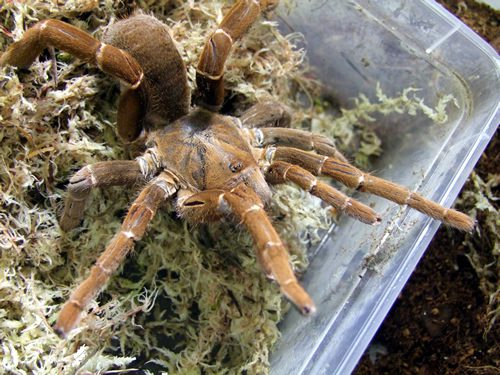Pelinobius muticus
King Baboon (5-6cm)
POCOCK 1900
Species Info:
Origin
Lifestyle
Temp
Humidity
Leg Span
Disposition
Suitability
This is the second largest African Tarantula (Or Baboon Spider) with a 20cm+ leg span! This species has a very unique appearance with a velvety rusty brown / orange colouration with enlarged and curved rear legs for digging. It inhabits the dry Acacia scrub lands of central eastern Africa, mainly Uganda, Tanzania and Kenya. It lives in burrows up to 2 meters in length which refuges remain cool and humid even on the hottest days. In captivity it needs a deep slightly moistened substrate that it can establish a burrow and prefer drier conditions. This species can also utilize the artificial retreats and drinking bowl must be provided. These Tarantulas are very hard to breed. The offspring are slow growers and females mature at around five years of age.
It can easily be separated from its close relatives in the Hysterocrates by its thickened rear legs and it is interesting that males don’t posses this unique character. A lot of attempts at breeding this species by hobbyists are known but rarely successful. Should the countries of export close they would become a rarity. Egg sacks are often produced by wild caught females. Native people are afraid of this species due to is aggressiveness and defensiveness when disturbed. Like a few other large spiders, the king baboon is able to produce a raspy hissing noise as part of its defence behaviour. The sound is produced by rubbing the hairs on the front legs together. . The other member of this genus is Citharischius stridulantissimus but due to its type being destroyed during world war II nobody knows what it should look like.


